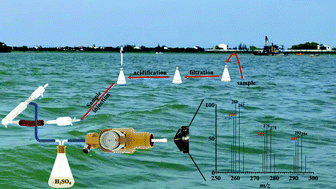Comparative study on a kilowatt-MPT-MS-based method with two ion polarity modes for the inert palladium metal†
Abstract
Inert metals are of much importance and play a key role in modern industrial manufacturing. The analytical techniques of inert metals remain challenging. In particular, the mass spectrometry of inert metal elements is yet to be further developed, which also limits the contemporary conceptual in situ analysis of inert metals. As the representative element, the mass spectral detection of palladium is critical and of far-reaching significance. Herein, we developed a mass spectrometry method, which can be used for the high-speed and in situ analysis of palladium, and even for other inert metals. Combining the line ion trap mass spectrometer with the versatile ambient ionization source, a novel kilowatt microwave plasma torch (MPT) can be used to obtain the fully characteristic MPT mass spectra of palladium. Detailed multistage tandem mass spectra show that the general form of target ions is [M(O2)x(NO)mNy(NO2)n]− for the negative ion mode and [M(H2O)x(NO2)y(N2)m]+ for the positive ion mode. Moreover, the formation and evolution of these palladium complex ions were reasonably derived based on the analysis of MPT background mass spectra. This mass spectrometric technique is also suitable for the determination of the palladium-containing solution in the sub-trace level. Semi-quantitative results showed that the detecting ability for palladium in the negative mode is better than that of the positive mode. Under the negative ion mode, the limit of detection (LOD) for m/z 259 were evaluated to be 0.5 μg L−1 under the optimized conditions of the negative mode, with the linear range of 1–100 μg·L−1 (R2 ≥ 0.9985) and the relative standard deviation (RSD, n = 11) being in the range of 1.20%–5.98% (refer to Table S3). Our experimental data showed that MPT-MS was a promising technique for providing another alternative in the on-site analysis of liquid samples and other intimate relevant fields, as the supplement of ICP-MS for the detection of inert metal elements. On the other hand, this work will also certainly promote the more broad applications of platinum-group elements (PGE) in modern science and industry.



 Please wait while we load your content...
Please wait while we load your content...